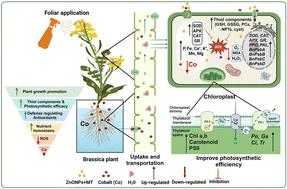当前位置:
X-MOL 学术
›
Environ. Sci.: Nano
›
论文详情
Our official English website, www.x-mol.net, welcomes your
feedback! (Note: you will need to create a separate account there.)
Synergistic effects of exogenous melatonin and zinc oxide nanoparticles in alleviating cobalt stress in Brassica napus: insights from stress-related markers and antioxidant machinery
Environmental Science: Nano ( IF 5.8 ) Pub Date : 2024-11-08 , DOI: 10.1039/d4en00821a
Skhawat Ali, Basharat Ali, Imtiaz Ahmad Sajid, Shoaib Ahmad, Muhammad Arslan Yousaf, Zaid Ulhassan, Kangni Zhang, Shafaqat Ali, Weijun Zhou, Bizeng Mao
Environmental Science: Nano ( IF 5.8 ) Pub Date : 2024-11-08 , DOI: 10.1039/d4en00821a
Skhawat Ali, Basharat Ali, Imtiaz Ahmad Sajid, Shoaib Ahmad, Muhammad Arslan Yousaf, Zaid Ulhassan, Kangni Zhang, Shafaqat Ali, Weijun Zhou, Bizeng Mao

|
Cobalt (Co) toxicity severely hinders plant growth, highlighting the imperative to devise strategies that promote plant growth and inhibit Co accumulation in plants. Melatonin (MT) and zinc oxide nanoparticles (ZnO NPs) have emerged as key contributors to promoting sustainable crop production and enhancing stress resistance. However, the mechanisms underlying the ameliorative effects of foliar applications of the growth regulators MT and/or ZnO NPs on Co accumulation and its associated phytotoxicity in Brassica napus remain poorly understood. To address this knowledge gap, the present study was carried out to investigate the protective roles of MT and/or ZnO NPs in promoting growth and enhancing tolerance against Co stress in B. napus. Treatment of Co (300 μM) alone significantly reduced the leaf fresh weight (33%), dry weight (49%), full plant height (51%), antioxidant enzyme activity and stomatal conductance. However, the application of MT (50 μM) with ZnO NPs (25 μM) resulted in a substantial decline in the accumulation of Co concentration and contents of MDA (33% in leaves and 26% in roots), H2O2 (41% in leaves and 35% in roots) and O2˙− (26% in leaves and 39% in roots). Additionally, combined application of MT + ZnO NPs markedly enhanced the activities of antioxidant enzymes as well as the levels of thiol compounds such as GSH, NPTs, PCs and Cys. Furthermore, the investigation of genes responsible for encoding the extrinsic proteins of photosystem II showed a marked upregulation in the expression levels of the BnPsbA, BnPsbB, BnPsbC, and BnPsbD genes. Remarkably, the synergistic application of MT and ZnO NPs proved more effective in promoting plant growth than their individual applications. Further, this study investigated the synergistic mechanisms by which MT and ZnO NPs, both individually and in combination, enhance enzymatic activities, improve photosynthetic capacity, and optimize nutrient accumulation in plants. Thus, this research provides insights into the biochemical and physiological processes underlying the ameliorative effects of these compounds on plant stress tolerance.
中文翻译:

外源褪黑激素和氧化锌纳米颗粒在缓解甘蓝型油菜钴胁迫中的协同作用:来自胁迫相关标志物和抗氧化机制的见解
钴 (Co) 毒性严重阻碍植物生长,凸显了制定促进植物生长和抑制植物中 Co 积累的策略的必要性。褪黑激素 (MT) 和氧化锌纳米颗粒 (ZnO NPs) 已成为促进可持续作物生产和增强抗逆性的关键贡献者。然而,叶面施用生长调节剂 MT 和/或 ZnO NPs 对甘蓝型油菜中 Co 积累及其相关植物毒性的改善作用的机制仍然知之甚少。为了解决这一知识差距,本研究旨在探讨 MT 和/或 ZnO NPs 在促进甘蓝型油菜生长和增强对 Co 胁迫的耐受性方面的保护作用。单独处理 Co (300 μM) 可显著降低叶片鲜重 (33%) 、干重 (49%) 、全株高度 (51%) 、抗氧化酶活性和气孔导度。然而,使用 MT (50 μM) 和 ZnO NPs (25 μM) 导致 Co 浓度和 MDA 含量(叶片中 33%,根中 26%)、H2O2(叶片中 41%,根中 35%)和 O2 ̇−(叶中 26%,根中 39%)的积累显着下降。此外,MT + ZnO NPs 的联合应用显着增强了抗氧化酶的活性以及 GSH、NPT、PC 和 Cys 等巯基化合物的水平。此外,对负责编码光系统 II 外源性蛋白的基因的研究显示 BnPsbA 、 BnPsbB 、 BnPsbC 和 BnPsbD 基因的表达水平显著上调。 值得注意的是,MT 和 ZnO NPs 的协同应用被证明比它们的单独应用更有效地促进植物生长。此外,本研究探讨了 MT 和 ZnO NPs 单独和组合增强酶活性、提高光合能力和优化植物养分积累的协同机制。因此,这项研究为这些化合物对植物抗逆性的改善作用背后的生化和生理过程提供了见解。
更新日期:2024-11-08
中文翻译:

外源褪黑激素和氧化锌纳米颗粒在缓解甘蓝型油菜钴胁迫中的协同作用:来自胁迫相关标志物和抗氧化机制的见解
钴 (Co) 毒性严重阻碍植物生长,凸显了制定促进植物生长和抑制植物中 Co 积累的策略的必要性。褪黑激素 (MT) 和氧化锌纳米颗粒 (ZnO NPs) 已成为促进可持续作物生产和增强抗逆性的关键贡献者。然而,叶面施用生长调节剂 MT 和/或 ZnO NPs 对甘蓝型油菜中 Co 积累及其相关植物毒性的改善作用的机制仍然知之甚少。为了解决这一知识差距,本研究旨在探讨 MT 和/或 ZnO NPs 在促进甘蓝型油菜生长和增强对 Co 胁迫的耐受性方面的保护作用。单独处理 Co (300 μM) 可显著降低叶片鲜重 (33%) 、干重 (49%) 、全株高度 (51%) 、抗氧化酶活性和气孔导度。然而,使用 MT (50 μM) 和 ZnO NPs (25 μM) 导致 Co 浓度和 MDA 含量(叶片中 33%,根中 26%)、H2O2(叶片中 41%,根中 35%)和 O2 ̇−(叶中 26%,根中 39%)的积累显着下降。此外,MT + ZnO NPs 的联合应用显着增强了抗氧化酶的活性以及 GSH、NPT、PC 和 Cys 等巯基化合物的水平。此外,对负责编码光系统 II 外源性蛋白的基因的研究显示 BnPsbA 、 BnPsbB 、 BnPsbC 和 BnPsbD 基因的表达水平显著上调。 值得注意的是,MT 和 ZnO NPs 的协同应用被证明比它们的单独应用更有效地促进植物生长。此外,本研究探讨了 MT 和 ZnO NPs 单独和组合增强酶活性、提高光合能力和优化植物养分积累的协同机制。因此,这项研究为这些化合物对植物抗逆性的改善作用背后的生化和生理过程提供了见解。

































 京公网安备 11010802027423号
京公网安备 11010802027423号